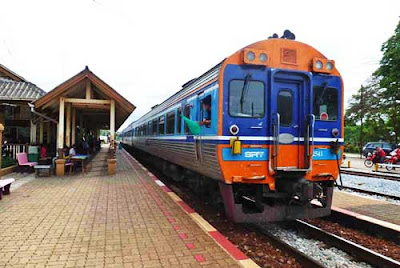The first day of Songkran, the traditional Thai New Year, fell on Monday, April 13 this year. Water plays a major role in the celebration, perhaps in hopeful anticipation of mid-May’s monsoon rains. At one time, young Thais would respectfully greet their elders by gently pouring perfumed water onto their cupped hands. Today the younger set gathers on the streets and exuberantly douses passers-by, cars, buses and themselves with water, using buckets, water cannon and the occasional fire hose. Almost anything goes.
To avoid the splash and dash this year, we accepted an invitation to visit friends in Ranong, some 350 miles (570 km) south of Bangkok.
 |
| Map of Thailand with enlarged section showing cities mentioned. (Modified from www.travelblog.org/Photos/6547487) |
 |
| Train #41 at Lang Suan Station, Chumpon. |
 |
| A sample of Tiew's oil palms. |
 |
| The author’s wife Thi with the plantation foreman and caretaker. |
Walking to the dam, we encountered a harvesting party on the way. One of the young men demonstrated how he used a long, steel, sharp, chisel-like tool, to remove the fruit, cutting at the base of the stem.
 |
| Sharpening the tool used to cut the fruit from the oil palm. |
 |
| Cutting the fruit from the oil palm. |
 |
| Oil palm fruit. |
 |
| Ripe oil palm seeds. |
The oil is extracted from the seed, filtering out impurities and using centrifuges to separate the oil from residual water. Eventually the refined oil finds its way into cooking oils, shortenings, butter substitutes, nondairy creamers and even ice cream as well as soaps.
 |
| Oil palm seed sliced open. |
 |
| Plantation caretaker with orchids. |
 |
| Author at rest stop on the way to the dam. |
That task accomplished, we bushwhacked back downhill until we found another old logging road, which led to a rubber plantation, the caretaker’s house and the short distance back to our hosts’ house for our next holiday adventure.
 |
| Thi on the way down through the rubber plantation. |
John's account of their holiday vacation adventures continues next Tuesday, when he shares the ins and outs of enlisting a monkey to harvest coconut. You won’t want to miss it. Thanks for stopping by.

No comments:
Post a Comment